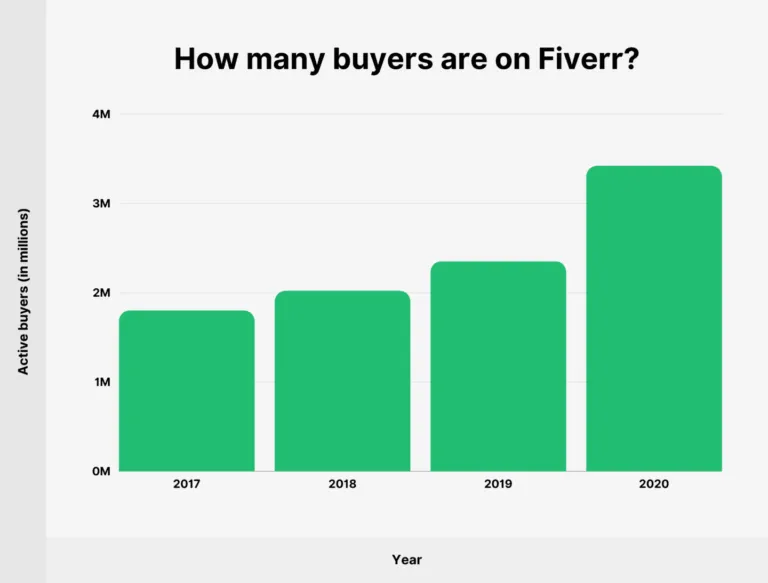In the ever-evolving gig economy, Fiverr stands out as a popular online marketplace where freelancers offer their services—or as Fiverr likes to call it, "gigs." But navigating this platform can sometimes feel a bit overwhelming, especially when it comes to understanding the fees and your potential earnings. Fear not! In this post, we’ll break down the ins and outs of Fiverr's percentage, so you can understand how much of your hard-earned cash stays in your pocket and how much goes to the platform. Let’s dive in!
What is Fiverr?

Fiverr is an online freelance marketplace that connects buyers and sellers around the globe. It’s a platform where freelancers can showcase their skills and talents, offering everything from graphic design and digital marketing to writing and programming. The beauty of Fiverr is its diverse range of services, catering to almost any need you might have—hence the name "Fiverr," which indicates that gigs start at just $5!
Here's a quick rundown of how Fiverr works:
- Service Offerings: Freelancers create profiles and list their services, known as “gigs,” with detailed descriptions, prices, and delivery times.
- Buying Process: Customers browse through the gigs and purchase those that meet their needs. They can also request custom offers from freelancers.
- Communication: Buyers and sellers can communicate directly through the Fiverr platform, allowing them to discuss project details before finalizing the order.
- Reviews and Ratings: After a service is completed, buyers can leave reviews and ratings, which helps build the freelancer’s reputation.
In a nutshell, Fiverr is an accessible platform for freelancers and a reliable resource for buyers seeking a wide variety of services at competitive prices. Whether you're a skilled freelancer looking to make some extra cash or a business seeking specialized services, Fiverr opens the door to countless opportunities.
Also Read This: Charges and Earnings of Freelance SEO Experts
Understanding Fiverr's Fee Structure

When you dive into the world of Fiverr, understanding the fee structure is crucial for both buyers and sellers. Fiverr operates on a straightforward model that prioritizes transparency. At a glance, here's how it works:
- Service Fee: Fiverr charges sellers a flat service fee of 20% on every sale. This means if you offer a gig for $100, you’ll receive $80, and Fiverr keeps $20.
- Buyer Service Fees: On the flip side, buyers also pay a service fee when they purchase a gig. This fee can vary based on the order size, typically ranging from $2 to $40. It’s worth noting that this fee structure can sometimes make gigs appear more expensive than they really are.
- Withdrawal Fees: Once you’ve made some cash, you’ll need to withdraw it. Fiverr has set fees depending on the withdrawal method, such as PayPal or a bank transfer. Always check the specifics for your preferred withdrawal method.
In essence, while the 20% cut might feel a bit steep for newcomers, it's important to remember the platform’s vast reach and resources that can help you grow your freelance business. Plus, Fiverr handles all the payment processing and buyer disputes, which is pretty valuable!
Also Read This: How to Make Money Online with Amazon Associates
How Much Does Fiverr Take from Your Earnings?

So, let’s break down precisely how much Fiverr takes from your hard-earned money. As mentioned earlier, Fiverr takes a 20% commission on every gig you sell. This percentage applies to the total amount of your gig price:
- If you set your gig price at $50, you’ll end up with $40 after Fiverr’s cut.
- For a $200 gig, you’ll take home $160.
This model is essential for budgeting your income on the platform. You can quickly calculate how much you’ll earn by subtracting 20% from your gig price. Another key point to remember is:
| Gig Amount | Fiverr’s Cut (20%) | Your Earnings |
|---|---|---|
| $10 | $2 | $8 |
| $50 | $10 | $40 |
| $100 | $20 | $80 |
Understanding this commission structure will help you set competitive prices while ensuring you’re still earning a decent profit. Knowing these details upfront can enhance your experience on Fiverr, allowing you to focus on what really matters: delivering great work and building your client base!
Also Read This: Does Fiverr Charge Like Google Services?
Types of Fees on Fiverr
When you dive into the world of Fiverr, it’s essential to wrap your head around the various fees that come into play. Understanding these fees not only helps you set your service prices accurately but also allows you to project your earnings more effectively.
Here are the primary types of fees you can encounter on Fiverr:
- Service Fee: Fiverr charges a service fee of 20% on every sale you make. This means that if you sell a gig for $100, you'll only receive $80 in your account. It’s important to factor in this fee when determining your pricing strategy.
- Processing Fees: Depending on how you choose to get paid, there may be additional processing fees. For instance, if you withdraw your earnings to PayPal or through direct deposit, a small fee may apply. It can vary by country and withdrawal method, so be sure to check Fiverr's payment details for your specific situation.
- Currency Conversion Fees: If you're working with international clients, currency conversion fees can sneak in. If you're earning in a different currency than your bank account's currency, you might face conversion charges when you withdraw your funds.
In summary, make sure you’re fully aware of these fees to help you maintain healthy profit margins. After all, the last thing you want is to be surprised after a successful gig!
Also Read This: How to Change Country in Your Fiverr Profile
How to Calculate Your Earnings on Fiverr
Calculating your earnings on Fiverr seems tricky at first, but once you get the hang of it, you'll find it’s pretty straightforward. The formula is simple, but let’s break it down step by step.
Here’s how you can calculate your earnings:
- Start with the Sale Amount: This is the total amount your gig sold for. Let’s say you sold a gig for $100.
- Subtract the Service Fee: Remember the 20% service fee? In this case, you’d lose $20 to Fiverr, which brings your earnings down to $80.
- Account for Processing Fees: If you choose to withdraw to PayPal, for example, and they charge a fee, subtract that amount. Suppose that fee is $2, then your total earnings now stand at $78.
To make it clearer, here’s a simple table:
| Description | Amount |
|---|---|
| Sale Amount | $100 |
| Service Fee (20%) | -$20 |
| Processing Fees | -$2 |
| Total Earnings | $78 |
So there you have it! By assessing each factor, you can confidently strategize around your earnings and adjust your gig pricing if necessary. Happy selling!
Also Read This: How to Get More Traffic on Your Fiverr Gig
Ways to Maximize Your Earnings on Fiverr
Diving into the world of Fiverr can be exciting, especially when you're looking to turn your skills into a lucrative side hustle or even a full-time gig. However, simply signing up and posting a few gigs isn't enough. To truly maximize your earnings, you need to be strategic and focused. Here are some effective ways to boost your income on Fiverr:
- Optimize Your Profile: Make your profile stand out. Use a professional photo and write a compelling bio that showcases your expertise and experience.
- Create Multiple Gigs: Don't just stick to one offering. Create multiple gigs that showcase different skills or variations of the same service. This will give clients more options to choose from.
- Offer Packages: Use Fiverr's package system to provide tiered pricing. This way, clients can choose what fits their budget and needs, and you can upsell your services.
- Promote Your Gigs: Use social media platforms, your own website, or blogs to promote your gigs. The more eyes on your services, the better chances you have of securing sales.
- Provide Exceptional Customer Service: Keep communication open, friendly, and prompt. Happy clients are more likely to leave positive reviews, which can help attract more buyers.
- Stay Updated and Adapt: Fiverr’s marketplace changes frequently. Stay updated on trends and adjust your offerings accordingly to meet the evolving demand.
- Request Reviews: After completing a job successfully, kindly request your client to leave a review. Positive feedback boosts your credibility and attracts more clients.
By implementing these strategies, you can enhance not only your Fiverr profile but your overall earning potential too!
Also Read This: How to Create a Transcription Gig on Fiverr
Common Questions About Fiverr Fees
When it comes to freelancing platforms like Fiverr, understanding the fee structure is vital for any seller. Let's address some of the most common questions about Fiverr fees to help you navigate your earnings better:
| Question | Answer |
|---|---|
| What percentage does Fiverr take from my earnings? | The standard fee is 20% of your total earnings per order. |
| Are there any additional fees for sellers? | No additional fees are charged apart from the standard commission on sales. |
| Do I have to pay fees on tips I receive? | Yes, Fiverr takes a 20% fee from the tips as well. |
| When do I get paid? | Fiverr releases payments about 14 days after the delivery of an order for new sellers. |
| Can I reduce the fee? | Currently, Fiverr does not offer a way to reduce the fee percentage. It's fixed at 20%. |
Understanding these aspects of Fiverr fees will help you plan better and set realistic earning goals. Remember to keep these questions in mind when starting out!
What is the Percentage on Fiverr? Understanding Fees and Earnings
When it comes to freelancing platforms like Fiverr, it's essential to understand the fee structure and how earnings are calculated. Fiverr charges a percentage on each transaction, which can affect the total income generated by gigs. Below is a breakdown of Fiverr's fee structure:
| Type of Transaction | Fiverr Fee Percentage | Final Earnings for Seller |
|---|---|---|
| Standard Gigs | 20% | 80% of the sale price |
| Custom Offers | 20% | 80% of the offered price |
| Add-on Services | 20% | 80% of the additional service price |
Additionally, Fiverr imposes a service fee on buyers that varies based on the order amount:
- Orders up to $40: $2 service fee
- Orders over $40: 5% of the order total
These fees are designed to maintain the platform and provide sellers with a venue to showcase their skills. However, understanding these fees is crucial for freelancers to price their services competitively and accurately predict their earnings.
In conclusion, while Fiverr takes a 20% cut from seller earnings, it's essential for freelancers to account for these fees when pricing their services to ensure they maintain a sustainable income while delivering value to clients.



